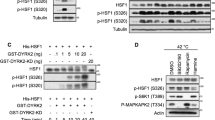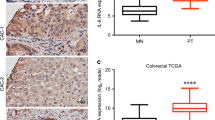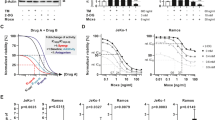Abstract
Co-chaperone p23 is a component of the heat-shock protein (Hsp)90 multiprotein-complex and is an important modulator of Hsp90 activity. Hsp90 client proteins involved in oncogenic survival signaling are frequently mutated in leukemia, and the integrity of the Hsp90 complex could therefore be important for leukemic cell survival. We demonstrate here that p23 is cleaved to a stable 17 kDa fragment in leukemic cell lines treated with commonly used chemotherapeutic drugs. The cleavage of p23 paralleled the activation of procaspase-7 and -3 and was suppressed by the caspase-3/-7 inhibitor DEVD-FMK. In vitro translated 35S-p23 (in reticulocyte lysate) was cleaved at D142 and D145 by caspase-7 and -3. Cleavage of p23 occurred in caspase-3-deficient MCF-7 cells, suggesting a role for caspase-7 in intact cells. The Hsp90 inhibitor geldanamycin enhanced caspase-dependent p23 cleavage both in vitro and in intact cells. Geldanamycin also enhanced anthracycline-induced caspase activation and apoptosis. We conclude that p23 is a prominent target in leukemic cell apoptosis. Geldanamycin enhanced p23 cleavage both by rendering p23 more susceptible to caspases and by enhancing chemotherapy-induced caspase activation. These findings underscore the importance of the Hsp90-complex in antileukemic treatment, and suggest that p23 may have a role in survival signaling.
This is a preview of subscription content, access via your institution
Access options
Subscribe to this journal
Receive 12 print issues and online access
$259.00 per year
only $21.58 per issue
Buy this article
- Purchase on Springer Link
- Instant access to full article PDF
Prices may be subject to local taxes which are calculated during checkout






Similar content being viewed by others
References
Droin N, Dubrez L, Eymin B, Renvoize C, Breard J, Dimanche-Boitrel MT et al. Upregulation of CASP genes in human tumor cells undergoing etoposide-induced apoptosis. Oncogene 1998; 16: 2885–2894.
Belaud-Rotureau MA, Durrieu F, Labroille G, Lacombe F, Fitoussi O, Agape P et al. Study of apoptosis-related responses of leukemic blast cells to in vitro anthracycline treatment. Leukemia 2000; 14: 1266–1275.
Gewirtz DA . A critical evaluation of the mechanisms of action proposed for the antitumor effects of the anthracycline antibiotics adriamycin and daunorubicin. Biochem Pharmacol 1999; 57: 727–741.
Laurent G, Jaffrezou JP . Signaling pathways activated by daunorubicin. Blood 2001; 98: 913–924.
Neckers L, Mimnaugh E, Schulte TW . Hsp90 as an anti-cancer target. Drug Resist Updat 1999; 2: 165–172.
Grenert JP, Sullivan WP, Fadden P, Haystead TA, Clark J, Mimnaugh E et al. The amino-terminal domain of heat shock protein 90 (hsp90) that binds geldanamycin is an ATP/ADP switch domain that regulates hsp90 conformation. J Biol Chem 1997; 272: 23843–23850.
Kamal A, Thao L, Sensintaffar J, Zhang L, Boehm MF, Fritz LC et al. A high-affinity conformation of Hsp90 confers tumour selectivity on Hsp90 inhibitors. Nature 2003; 425: 407–410.
Banerji U, Judson I, Workman P . The clinical applications of heat shock protein inhibitors in cancer – present and future. Curr Cancer Drug Targets 2003; 3: 385–390.
Richter K, Buchner J . Hsp90: chaperoning signal transduction. J Cell Physiol 2001; 188: 281–290.
Pratt WB, Toft DO . Regulation of signaling protein function and trafficking by the hsp90/hsp70-based chaperone machinery. Exp Biol Med (Maywood) 2003; 228: 111–133.
Pratt WB, Toft DO . Steroid receptor interactions with heat shock protein and immunophilin chaperones. Endocr Rev 1997; 18: 306–360.
Neckers L, Schulte TW, Mimnaugh E . Geldanamycin as a potential anti-cancer agent: its molecular target and biochemical activity. Invest New Drugs 1999; 17: 361–373.
Bose S, Weikl T, Bugl H, Buchner J . Chaperone function of Hsp90-associated proteins. Science 1996; 274: 1715–1717.
Freeman BC, Toft DO, Morimoto RI . Molecular chaperone machines: chaperone activities of the cyclophilin Cyp-40 and the steroid aporeceptor-associated protein p23. Science 1996; 274: 1718–1720.
Johnson JL, Toft D . Binding of p23 and hsp90 during assembly with the progesterone receptor. Mol Endocrinol 1995; 9: 670–678.
Mimnaugh EG, Chavany C, Neckers L . Polyubiquitination and proteasomal degradation of the p185c-erbB-2 receptor protein-tyrosine kinase induced by geldanamycin. J Biol Chem 1996; 271: 22796–22801.
An WG, Schulte TW, Neckers LM . The heat shock protein 90 antagonist geldanamycin alters chaperone association with p210bcr-abl and v-src proteins before their degradation by the proteasome. Cell Growth Differ 2000; 11: 355–360.
Donze O, Abbas-Terki T, Picard D . The Hsp90 chaperone complex is both a facilitator and a repressor of the dsRNA-dependent kinase PKR. EMBO J 2001; 20: 3771–3780.
Vanden Berghe T, Kalai M, van Loo G, Declercq W, Vandenabeele P . Disruption of HSP90 function reverts tumor necrosis factor-induced necrosis to apoptosis. J Biol Chem 2003; 278: 5622–5629.
Mollerup J, Krogh TN, Nielsen PF, Berchtold MW . Properties of the co-chaperone protein p23 erroneously attributed to ALG-2 (apoptosis-linked gene 2). FEBS Lett 2003; 555: 478–482.
Weikl T, Abelmann K, Buchner J . An unstructured C-terminal region of the Hsp90 co-chaperone p23 is important for its chaperone function. J Mol Biol 1999; 293: 685–691.
Schagger H, von Jagow G . Tricine-sodium dodecyl sulfate-polyacrylamide gel electrophoresis for the separation of proteins in the range from 1 to 100 kDa. Anal Biochem 1987; 166: 368–379.
Kobayashi T, Nakatani Y, Tanioka T, Tsujimoto M, Nakajo S, Nakaya K et al. Regulation of cytosolic prostaglandin E synthase by phosphorylation. Biochem J 2004; 381: 59–69.
Lanotte M, Martin-Thouvenin V, Najman S, Balerini P, Valenci F, Berger R . NB4, a maturation inducible cell line with t(15;17) marker isolated from a human acute promyelocytic leukemia (M3). Blood 1991; 77: 1080–1086.
Strasser A, O’Connor L, Dixit VM . Apoptosis signaling. Annu Rev Biochem 2000; 69: 217–245.
Tewari M, Quan LT, O’Rourke K, Desnoyers S, Zeng Z, Beidler DR et al. Yama/CPP32 beta, a mammalian homolog of CED-3, is a CrmA-inhibitable protease that cleaves the death substrate poly(ADP-ribose) polymerase. Cell 1995; 81: 801–809.
Germain M, Affar EB, D’Amours D, Dixit VM, Salvesen GS, Poirier GG . Cleavage of automodified poly(ADP-ribose) polymerase during apoptosis. Evidence for involvement of caspase-7. J Biol Chem 1999; 274: 28379–28384.
Slee EA, Adrain C, Martin SJ . Executioner caspase-3, -6, and -7 perform distinct, non-redundant roles during the demolition phase of apoptosis. J Biol Chem 2001; 276: 7320–7326.
Janicke RU, Sprengart ML, Wati MR, Porter AG . Caspase-3 is required for DNA fragmentation and morphological changes associated with apoptosis. J Biol Chem 1998; 273: 9357–9360.
Thornberry NA . Caspases: key mediators of apoptosis. Chem Biol 1998; 5: R97–103.
Pandey P, Saleh A, Nakazawa A, Kumar S, Srinivasula SM, Kumar V et al. Negative regulation of cytochrome c-mediated oligomerization of Apaf-1 and activation of procaspase-9 by heat shock protein 90. EMBO J 2000; 19: 4310–4322.
Rashmi R, Santhosh Kumar TR, Karunagaran D . Human colon cancer cells differ in their sensitivity to curcumin-induced apoptosis and heat shock protects them by inhibiting the release of apoptosis-inducing factor and caspases. FEBS Lett 2003; 538: 19–24.
Chant ID, Rose PE, Morris AG . Analysis of heat-shock protein expression in myeloid leukaemia cells by flow cytometry. Br J Haematol 1995; 90: 163–168.
Felts SJ, Toft DO . p23, a simple protein with complex activities. Cell Stress Chaperones 2003; 8: 108–113.
Oxelmark E, Knoblauch R, Arnal S, Su LF, Schapira M, Garabedian MJ . Genetic dissection of p23, an Hsp90 cochaperone, reveals a distinct surface involved in estrogen receptor signaling. J Biol Chem 2003; 278: 36547–36555.
Tanioka T, Nakatani Y, Semmyo N, Murakami M, Kudo I . Molecular identification of cytosolic prostaglandin E2 synthase that is functionally coupled with cyclooxygenase-1 in immediate prostaglandin E2 biosynthesis. J Biol Chem 2000; 275: 32775–32782.
Tanioka T, Nakatani Y, Kobayashi T, Tsujimoto M, Oh-ishi S, Murakami M et al. Regulation of cytosolic prostaglandin E2 synthase by 90-kDa heat shock protein. Biochem Biophys Res Commun 2003; 303: 1018–1023.
Sandal T, Stapnes C, Kleivdal H, Hedin L, Doskeland SO . A novel, extraneuronal role for cyclin-dependent protein kinase 5 (CDK5): modulation of cAMP-induced apoptosis in rat leukemia cells. J Biol Chem 2002; 277: 20783–20793.
Krakstad C, Christensen AE, Doskeland SO . cAMP protects against TNF-{alpha}-induced apoptosis by activation of cAMP-dependent protein kinase, independently of exchange protein directly activated by cAMP (Epac). J Leukoc Biol 2004; 76: 641–647.
Korfali N, Ruchaud S, Loegering D, Bernard D, Dingwall C, Kaufmann SH et al. Caspase-7 gene disruption reveals an involvement of the enzyme during the early stages of apoptosis. J Biol Chem 2004; 279: 1030–1039.
Morita A, Suzuki N, Matsumoto Y, Hirano K, Enomoto A, Zhu J et al. p41 as a possible marker for cell death is generated by caspase cleavage of p42/SETbeta in irradiated MOLT-4 cells. Biochem Biophys Res Commun 2000; 278: 627–632.
Jung YS, Kim KS, Kim KD, Lim JS, Kim JW, Kim E . Apoptosis-linked gene 2 binds to the death domain of Fas and dissociates from Fas during Fas-mediated apoptosis in Jurkat cells. Biochem Biophys Res Commun 2001; 288: 420–426.
Nimmanapalli R, O’Bryan E, Kuhn D, Yamaguchi H, Wang HG, Bhalla KN . Regulation of 17-AAG-induced apoptosis: role of Bcl-2, Bcl-XL, and Bax downstream of 17-AAG-mediated down-regulation of Akt, Raf-1, and Src kinases. Blood 2003; 102: 269–275.
Schulte TW, Neckers LM . The benzoquinone ansamycin 17-allylamino-17-demethoxygeldanamycin binds to HSP90 and shares important biologic activities with geldanamycin. Cancer Chemother Pharmacol 1998; 42: 273–279.
Hutchison KA, Stancato LF, Owens-Grillo JK, Johnson JL, Krishna P, Toft DO et al. The 23-kDa acidic protein in reticulocyte lysate is the weakly bound component of the hsp foldosome that is required for assembly of the glucocorticoid receptor into a functional heterocomplex with hsp90. J Biol Chem 1995; 270: 18841–18847.
Murphy PJ, Kanelakis KC, Galigniana MD, Morishima Y, Pratt WB . Stoichiometry, abundance, and functional significance of the hsp90/hsp70-based multiprotein chaperone machinery in reticulocyte lysate. J Biol Chem 2001; 276: 30092–30098.
Blagosklonny MV, Fojo T, Bhalla KN, Kim JS, Trepel JB, Figg WD et al. The Hsp90 inhibitor geldanamycin selectively sensitizes Bcr-Abl-expressing leukemia cells to cytotoxic chemotherapy. Leukemia 2001; 15: 1537–1543.
Yao Q, Nishiuchi R, Li Q, Kumar AR, Hudson WA, Kersey JH . Flt3 expressing leukemias are selectively sensitive to inhibitors of the molecular chaperone heat shock protein 90 through destabilization of signal transduction-associated kinases. Clin Cancer Res 2003; 9: 4483–4493.
Acknowledgements
This study was supported by the Norwegian Cancer Society, PROBE National Proteomics Unit at the University of Bergen, The Norwegian Research Council FUGE Grant number 151859 and Interuniversity Attraction Poles IUAP B5/05 (J.V.). The expert assistance of Magda Puype, Nina Lied-Larsen, Erna Finsås, Line Wergeland and Therese Bredholt is highly appreciated.
Author information
Authors and Affiliations
Corresponding author
Rights and permissions
About this article
Cite this article
Gausdal, G., Gjertsen, B., Fladmark, K. et al. Caspase-dependent, geldanamycin-enhanced cleavage of co-chaperone p23 in leukemic apoptosis. Leukemia 18, 1989–1996 (2004). https://doi.org/10.1038/sj.leu.2403508
Received:
Accepted:
Published:
Issue Date:
DOI: https://doi.org/10.1038/sj.leu.2403508
Keywords
This article is cited by
-
Anti-leukemia activity of a Hsp70 inhibitor and its hybrid molecules
Scientific Reports (2017)
-
Functional p53 is required for rapid restoration of daunorubicin-induced lesions of the spleen
BMC Cancer (2013)
-
Cyclic AMP can promote APL progression and protect myeloid leukemia cells against anthracycline-induced apoptosis
Cell Death & Disease (2013)
-
Cyclic AMP induces IPC leukemia cell apoptosis via CRE-and CDK-dependent Bim transcription
Cell Death & Disease (2011)
-
Ubiquitin conjugase UBCH8 targets active FMS-like tyrosine kinase 3 for proteasomal degradation
Leukemia (2010)



